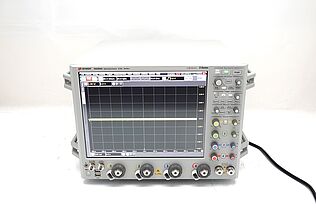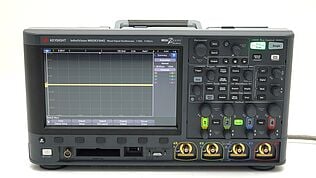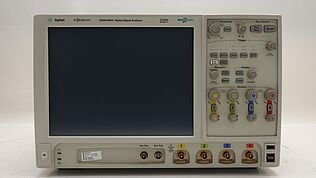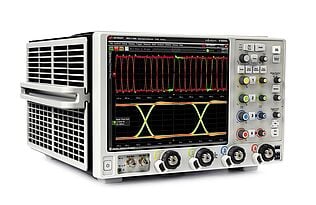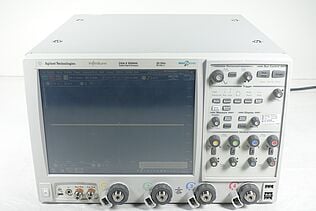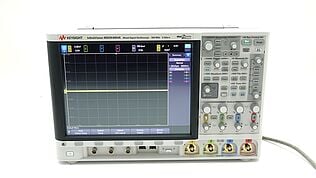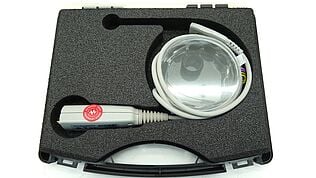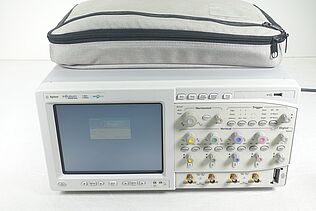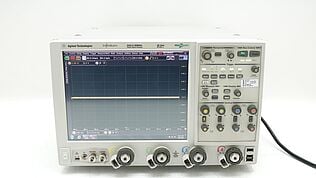- Introduction
- Understanding the Basics of Oscilloscopes
- Key Components of an Oscilloscope
- Oscilloscope Sweep Speed: Definition and Importance
- Why is Sweep Speed Crucial?
- High Resolution
- Viewing Frequency
- Capturing Transients
- Factors Affecting Sweep Speed
- Signal Frequency
- Waveform Detail
- Oscilloscope Bandwidth
- How to Adjust Sweep Speed on Oscilloscopes
- Understanding the Sweep Speed Scale
- Guidelines for Sweep Speed Selection
- Conclusion
- Whenever You’re Ready, Here Are 5 Ways We Can Help You
- Browse Our Deals of Used Oscilloscopes With Biggest Savings
What if you could slow down time, observe a moment stretching on indefinitely, or compress an age into a blink? If you're a physics enthusiast, you might instantly think of traveling at the speed of light or venturing into a black hole to experience such time dilation. However, for electrical engineers and technicians around the world, it is just part of the job.
An oscilloscope, often referred to as the "eye" of an electronic engineer, serves as a time machine, of sorts. It grants the ability to explore electrical signals as they unfold in time, letting us view phenomena that occur at speeds far beyond human perception. The key to this extraordinary power lies in understanding and controlling one pivotal factor – the oscilloscope's sweep speed.
In this article we’ll deep dive into the concept of sweep speed. We'll learn its definition, significance, and the intricacies of how it interacts with the signals we measure.
Buy Oscilloscopes at a Great Discount
Understanding the Basics of Oscilloscopes
Oscilloscopes are specialized test instruments that generate a visual representation of electrical signals as a function of time. The standard graphical representation known as a waveform is plotted with voltage (y-axis) against time (x-axis).
Key Components of an Oscilloscope
To fully comprehend the concept of sweep speed, it's essential to understand the three main elements of an oscilloscope:
- Display: Where waveforms are visualized.
- Vertical System: Controls the amplitude of the signal.
- Horizontal System: Controls the time base or sweep speed.
| Key Takeaway |
|---|
| Understanding and correctly adjusting the sweep speed on your oscilloscope is crucial to accurately visualize and analyze electrical signals, allowing you to tailor your view from the minutest details of high-frequency signals to the broader trends of low-frequency waveforms. |
Oscilloscope Sweep Speed: Definition and Importance
In an oscilloscope, sweep speed, controlled by the horizontal system, refers to how quickly the electron beam moves across the screen to plot the voltage versus time graph. Typically, the measurement is expressed in seconds per division (s/div), with each division representing one of the graticules on the oscilloscope screen.
Why is Sweep Speed Crucial?
The sweep speed is an important feature of an oscilloscope. It helps adjust the timescale and affects how we see electrical signals. Let's delve deeper into the three primary reasons that elevate the importance of sweep speed.
High Resolution
Imagine trying to read a book from a distance – you can see the entire page at a glance, but the words are too small to discern. Move the book closer, and suddenly the words become clear, readable. The same principle applies to electrical signals and sweep speed.
Faster sweep speeds function like a magnifying glass for your signal. They stretch out the timescale, causing the signal to take up more horizontal space on your oscilloscope screen. This "stretching" lets you zoom into a signal and observe finer details that would be too condensed to see at slower sweep speeds.
For example, if you're investigating a signal's noise, jitter, or minor anomalies, a fast sweep speed can help you clearly see these attributes. This expanded view allows for more precise analysis and troubleshooting, making it invaluable for signal integrity tasks.
Viewing Frequency
Conversely, slower sweep speeds come into play when observing lower frequency or slower signals. In these scenarios, a fast sweep speed would stretch the signal so much that only a fraction of it could be seen on the screen, much like zooming into a photo so much that you can only see a pixel.
A slower sweep speed compresses the signal, allowing more cycles of a low-frequency signal to fit on the screen at once. This overview can be incredibly beneficial when looking at overall signal trends over time, or when investigating phenomena like drift, which happens gradually and might not be apparent when looking at a tiny sliver of the signal.
Capturing Transients
Transient events in electrical signals are essentially the electrical equivalent of a "blink, and you'll miss it" situation. They are short-duration phenomena, often resulting from changes in the signal conditions, like a sudden power surge, an intermittent glitch or an abrupt change in load. Capturing and analyzing these transients can be crucial for tasks like designing power supplies or troubleshooting intermittent problems.
The right sweep speed allows you to catch these transients effectively. Too slow, and the transient might happen in between sweeps, effectively rendering it invisible. Too fast, and the transient might only cover a tiny fraction of the screen, making it hard to observe in detail. Striking the right balance allows you to view the entire transient event clearly, enabling you to accurately determine its characteristics and, subsequently, its causes.
Factors Affecting Sweep Speed
The correct selection of sweep speed is pivotal in the accurate visualization and interpretation of electrical signals. While the precise sweep speed may vary depending on the task at hand, it's generally influenced by the following three factors: Signal frequency, waveform detail, and oscilloscope bandwidth.
Signal Frequency
One of the most fundamental considerations when selecting a sweep speed is the frequency of the signal under examination. Higher frequencies involve faster-changing signals. To visualize these accurately on an oscilloscope, the sweep speed must be correspondingly fast.
Think of trying to capture a hummingbird's wing-flap – a standard camera won't be able to capture the details due to the speed of the movement. A high-speed camera, however, can capture each minute detail of the motion. Similarly, a faster sweep speed allows for an accurate representation of high-frequency signals.
On the other hand, for slower, low-frequency signals, a slower sweep speed is more appropriate. This scenario is akin to using a time-lapse camera to capture a sunset. If the camera took photos too quickly, the sunset would seem abrupt and choppy. A slower pace, however, would capture the smooth transition of colors.
Waveform Detail
The level of detail needed from a waveform also directly impacts the choice of sweep speed. If you need to investigate minute details or anomalies within a signal, a faster sweep speed is typically necessary. This enhanced resolution allows for a closer examination of the waveform, revealing elements like signal noise or minor distortions that may not be evident at slower sweep speeds.
Oscilloscope Bandwidth
Finally, the oscilloscope's bandwidth itself plays a crucial role in determining the sweep speed. The bandwidth of an oscilloscope is essentially the range of frequencies it can accurately measure. It directly impacts how quickly the oscilloscope can process incoming signals and, by extension, how fast it can sweep across the screen.
For instance, if an oscilloscope has a bandwidth of 100 MHz, it may not accurately represent signals beyond this frequency, even if the sweep speed is set to a high value. On the other hand, for signals well within the oscilloscope's bandwidth, a faster sweep speed can be used to capture and display detailed aspects of the waveform.
In essence, the oscilloscope's bandwidth sets an upper limit to the sweep speed that can be used effectively. It's akin to the maximum speed limit on a highway – going beyond this limit will not yield accurate or safe results.
How to Adjust Sweep Speed on Oscilloscopes
Setting the correct sweep speed is a crucial part of achieving accurate results when using an oscilloscope. Follow these steps to adjust it properly:
- Start with a moderate sweep speed.
- Observe the waveform. If it appears stretched out or too sparse, increase the sweep speed. If it seems compressed or crowded, decrease the sweep speed.
- Repeat this process until you find the ideal balance that allows clear and accurate visualization of your signal.
Understanding the Sweep Speed Scale
In both digital and analog oscilloscopes, the sweep speed is usually represented in:
- Seconds per division (s/div)
- Milliseconds per division (ms/div)
- Microseconds per division (μs/div)
- Nanoseconds per division (ns/div)
Let's say you have your oscilloscope set to 1 ms/div. This means each horizontal division on the oscilloscope's screen represents 1 millisecond of real time. A signal that spans five divisions on the screen, for instance, represents an event that occurred over 5 milliseconds.
However, as you adjust the sweep speed to faster settings, the scale changes. If you were to adjust the sweep speed to 1 μs/div, then each division now represents only 1 microsecond of real time.
The important thing to remember is that the sweep speed scale essentially zooms the time axis in or out, much like a microscope adjusting its magnification. A slower sweep speed (higher s/div or ms/div setting) zooms out to show more of the signal over a longer time, while a faster sweep speed (lower μs/div or ns/div setting) zooms in to show detailed behavior over a shorter time.
Guidelines for Sweep Speed Selection
Here's a useful table outlining some common signal types and suggested sweep speeds.
| Signal Type | Frequency | Suggested Sweep Speed |
|---|---|---|
| Audio Signals | 20 Hz – 20 kHz | 1 ms/div – 50 µs/div |
| Video Signals | 1 MHz – 10 MHz | 100 ns/div – 10 ns/div |
| RF Signals | > 1 GHz | < 1 ns/div |
Conclusion
Mastering sweep speed is paramount to getting the most out of your oscilloscope. It's the critical variable that allows us to zoom into high-frequency signals to observe minute details or capture the broader overview of a low-frequency waveform.
Remember, the choice of sweep speed hinges on three primary considerations: the frequency of the signal you're investigating, the level of detail required from the waveform, and your oscilloscope's bandwidth. By skillfully balancing these factors, you can ensure precise visualization and analysis of your electrical signals.
If you're considering enhancing your toolkit with the best quality oscilloscopes, signal analyzers and network analyzers, look no further than the Keysight.
We offer a wide selection of rigorously tested and certified pre-owned testing and measurement equipment. Keysight ensures you get top-tier performance at cost-effective prices. Explore the Keysight Used Equipment Store now and find the ideal instruments to perfect your skills in managing sweep speed.
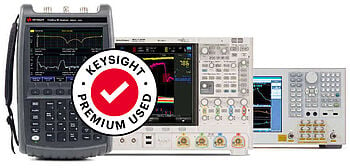
Whenever You’re Ready, Here Are 5 Ways We Can Help You
- Browse our Premium Used Oscilloscopes.
- Call tech support US: +1 800 829-4444
Press #, then 2. Hours: 7 am – 5 pm MT, Mon– Fri - Talk to our sales support team by clicking the icon (bottom right corner) on every offer page
- Create an account to get price alerts and access to exclusive waitlists.
- Talk to your account manager about your specific needs.

Subscribe to Get Our Latest News, Updates, and Articles.
Browse Our Deals of Used Oscilloscopes With Biggest Savings
Select up to 3 instruments to compare
Enable Notifications
In order to use this feature, you need to enable notifications.
Manage notification preferences
